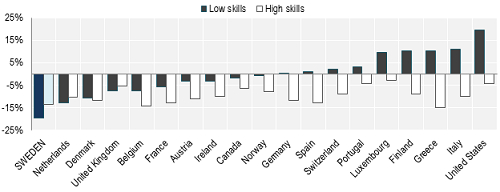Sweden in a strong position to integrate refugees, but support for the low skilled needs to be strengthened
Sweden should address housing shortages, begin integration activities early, and improve the support for those with low skills to speed up the effective integration of refugees, according to a new OECD report.
Employment disparities by educational attainment (2014)

Percentage point differences in the employment/population ratios between native- and foreig-born, 25-64 years old
Working together – Skills and labour market integration of immigrants and their children says that in 2014-2015, Sweden saw the largest per-capita inflow of asylum seekers ever recorded in an OECD country. With a strong economy and well-developed integration infrastructure, Sweden is better equipped than many other OECD countries to integrate refugees, but the large number of arrivals is testing the efficiency of the reception and integration system.
"While innovative policies to speed the labour market integration of skilled migrants have been introduced, more needs to be done to help others, particularly women, people with low skills, and those who arrive around the end of compulsory schooling" said Stefano Scarpetta, OECD Director for Employment, Labour and Social Affairs, presenting the report in Stockholm with Sweden’s Minister for Employment, Ylva Johansson. “Helping all refugees acquire basic foundational skills and supporting employers in their use of migrant skills would help."
The shortage of housing has led to settlement delays that postpone the start of integration activities. Sweden’s highly-skilled labour market, where only 5% of the jobs require only low levels of skills, presents a challenge for new arrivals with low levels of education, who generally have difficulty fulfilling the requirements of more demanding positions.
The cornerstone of Swedish integration policy is a two-year introduction programme of education and labour market activities to promote job readiness. While the programme is often too long for highly-educated migrants, those lacking basic skills need a more flexible approach combining longer-term educational support with gradual labour market introduction. In 2015, only 28% of low-educated foreign-born men and 19% of low-educated women were in employment one year after the programme.
Tight budgets will require efficiency improvements
Stronger and more structured co-ordination between the Public Employment Service and the municipalities is required to ensure coherent pathways to employment and avoid duplication of services. Wage subsidies to promote employment of migrants are effective but they tend to be too complex and the burdensome administration has limited uptake; reforms are needed to ease the path into unsubsidised employment, the OECD report finds.
Many municipalities in Sweden have been reluctant to settle refugees, in part due to the high cost of social assistance for those who do not get jobs. After three years in Sweden, employment rates among low-educated refugees are less than half those seen among the medium- and highly-educated refugees and funding mechanisms should reflect expected costs.
As in many other OECD countries, the children of immigrants do worse than children with native-born parents. In Sweden, these differences are smaller than elsewhere, which is particularly striking considering the challenges faced by their parents – many of whom arrived as refugees. This is an indication of successful integration in the long-term, according to the report. At present, Sweden is facing the challenge of providing help to the large number of asylum seekers below 18 (71 000 in 2015), half of whom arrived unaccompanied and are particularly vulnerable. Many are keen to enter the labour market but often lack the necessary skills. More should be done to ensure these young arrivals remain in school in order to boost their long-term job prospects.
Source: Organization for Economic Co-operation and Development
- 329 reads
Human Rights
Fostering a More Humane World: The 28th Eurasian Economic Summi

Conscience, Hope, and Action: Keys to Global Peace and Sustainability

Ringing FOWPAL’s Peace Bell for the World:Nobel Peace Prize Laureates’ Visions and Actions

Protecting the World’s Cultural Diversity for a Sustainable Future

Puppet Show I International Friendship Day 2020

